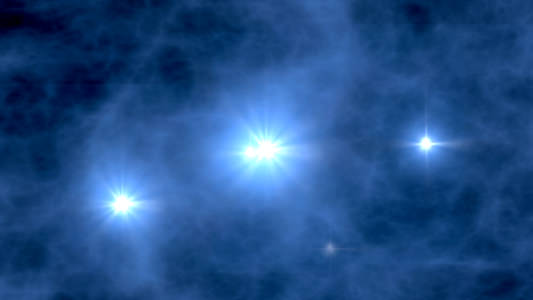[/caption]
Astronomers now know that the Big Bang occurred 13.7 billion years ago. For the first few hundred million years, the entire Universe was too hot any stars to form. But then the Universe cooled down to the point that gravity could start pulling together the raw hydrogen and helium into the first ever stars.
The basic elements on the Universe, hydrogen and helium and a few trace elements, we formed during the Big Bang. For a brief moment, the entire Universe was at the temperature and pressure that hydrogen could fuse into helium. This is why we see roughly the same ratios of hydrogen to helium, everywhere we look in the Universe: 73% hydrogen, 25% helium, and the rest are trace elements.
Astronomers think that this pure hydrogen/helium mix allowed the first stars to grow much more massive than stars can get today. It’s believed that they could have gathered together several hundred solar masses. The most massive star that can form today is thought to only be about 150 solar masses. After that point, extreme winds coming from the star prevent any additional material from falling in.
This first generation of stars, which astronomers call Population III stars, would have lived short violent lives. They probably lasted just a million years or so, and then detonated as supernovae. But in their lives, these Population III stars would have created heavier and heavier elements at their cores, and in their violent deaths, they would have created the even more exotic heavier elements, like gold and uranium. It’s possible that the first stars went through a few quick cycles, pulling in material, detonating and seeing the region with heavier elements. Eventually the first long-term stars would have gotten going, stars with the amount of heavier elements we see today.
None of the first stars have ever been observed directly. There have been a few hints through gravitational lensing; using a nearby galaxy’s gravity to focus the light from a more distant quasar. The next generation of space telescopes, like the James Webb Space Telescope might be able to push the observable Universe back to these first stars.
We have written many articles about stars here on Universe Today. Here’s an article about astronomers simulating the formation of the first stars, and here’s an article about how the first stars could have been powered by dark matter.
Want more information on stars? Here’s Hubblesite’s News Releases about Stars, and more information from NASA’s imagine the Universe.
We have recorded several episodes of Astronomy Cast about stars. Here are two that you might find helpful: Episode 12: Where Do Baby Stars Come From, and Episode 13: Where Do Stars Go When they Die?
Source: Caltech IPAC

